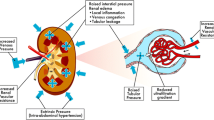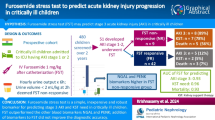Abstract
Acute kidney injury is a heterogeneous clinical syndrome encompassing a spectrum of risk factors and acute insults, occurring in multiple settings and affecting both short-term and long-term outcomes. Obesity has become an epidemic. The available literature suggests that AKI is common in critically ill surgical or medical obese patients and that obesity is a novel risk factor for this acute renal syndrome. The pathophysiology of obesity-associated AKI is not completely understood. Obesity-related factors combined with the burden of other comorbidities in elderly obese patients may interact with known precipitating factors such as hypotension, nephrotoxins or sepsis and increase the susceptibility of this population to AKI. Whether or not obesity may counterintuitively be protective and associated with better survival of critically ill patients with AKI (“reverse epidemiology”) is a subject for debate. Further investigations exploring the role of novel biomarkers and optimal management are needed urgently.

Similar content being viewed by others
References
Apovian CM (2013) The clinical and economic consequences of obesity. Am J Manag Care 19:s219–s228
WHO (2000) Obesity: preventing and aaging the global epidemic. Report of a WHO consultation. WHO Technical Report Series: 498
Suneja M, Kumar AB (2014) Obesity and perioperative acute kidney injury: a focused review. J Crit Care 29:694.e1–694.e6
Shashaty MG, Stapleton RD (2014) Physiological and management implications of obesity in critical illness. Ann Am Thorac Soc 11:1286–1297
Goh R, Darvall J, Wynne R, Tatoulis J (2016) Obesity prevalence and associated outcomes in cardiothoracic patients: a single-centre experience. Anaesth Intensive Care 44:77–84
Akinnusi ME, Pineda LA, El Solh AA (2008) Effect of obesity on intensive care morbidity and mortality: a meta-analysis. Crit Care Med 36:151–158
De Jong A, Molinari N, Pouzeratte Y, Verzilli D, Chanques G, Jung B et al (2015) Difficult intubation in obese patients: incidence, risk factors, and complications in the operating theatre and in intensive care units. Br J Anaesth 114:297–306
Robinson MK, Mogensen KM, Casey JD, McKane CK, Moromizato T, Rawn JD et al (2015) The relationship among obesity, nutritional status, and mortality in the critically ill. Crit Care Med 43:87–100
Danziger J, Chen KP, Lee J, Feng M, Mark RG, Celi LA et al (2016) Obesity, acute kidney injury, and mortality in critical illness. Crit Care Med 44:328–334
Billings FTT, Pretorius M, Schildcrout JS, Mercaldo ND, Byrne JG, Ikizler TA et al (2012) Obesity and oxidative stress predict AKI after cardiac surgery. J Am Soc Nephrol 23:1221–1228
Soto GJ, Frank AJ, Christiani DC, Gong MN (2012) Body mass index and acute kidney injury in the acute respiratory distress syndrome. Crit Care Med 40:2601–2608
Druml W, Metnitz B, Schaden E, Bauer P, Metnitz PG (2010) Impact of body mass on incidence and prognosis of acute kidney injury requiring renal replacement therapy. Intensive Care Med 36:1221–1228
Kelz RR, Reinke CE, Zubizarreta JR, Wang M, Saynisch P, Even-Shoshan O et al (2013) Acute kidney injury, renal function, and the elderly obese surgical patient: a matched case-control study. Ann Surg 258:359–363
Ward DT, Metz LN, Horst PK, Kim HT, Kuo AC (2015) Complications of morbid obesity in total joint arthroplasty: risk stratification based on bmi. J Arthroplast 30:42–46
Yap CH, Mohajeri M, Yii M (2007) Obesity and early complications after cardiac surgery. Med J Aust 186:350–354
Kumar AB, Bridget Zimmerman M, Suneja M (2014) Obesity and post-cardiopulmonary bypass-associated acute kidney injury: a single-center retrospective analysis. J Cardiothorac Vasc Anesth 28:551–556
O’Sullivan KE, Byrne JS, Hudson A, Murphy AM, Sadlier DM, Hurley JP (2015) The effect of obesity on acute kidney injury after cardiac surgery. J Thorac Cardiovasc Surg 150:1622–1628
Tekeli Kunt A, Parlar H, Findik O, Duzyol C, Baris O, Balci C (2016) The influence of metabolic syndrome on acute kidney injury occurrence after coronary artery bypass grafting. Heart Surg Forum 19:E099–E103
Weingarten TN, Gurrieri C, McCaffrey JM, Ricter SJ, Hilgeman ML, Schroeder DR et al (2013) Acute kidney injury following bariatric surgery. Obes Surg 23:64–70
Abdullah HR, Tan TP, Vaez M, Deb C, Farag N, Jackson TD et al (2016) Predictors of perioperative acute kidney injury in obese patients undergoing laparoscopic bariatric surgery: a single-centre retrospective cohort study. Obes Surg 26:1493–1499
Sharma SK, McCauley J, Cottam D, Mattar SG, Holover S, Dallal R et al (2006) Acute changes in renal function after laparoscopic gastric surgery for morbid obesity. Surg Obes Relat Dis 2:389–392
McCullough PA, Gallagher MJ, Dejong AT, Sandberg KR, Trivax JE, Alexander D et al (2006) Cardiorespiratory fitness and short-term complications after bariatric surgery. Chest 130:517–525
Morgan DJ, Ho KM, Armstrong J, Baker S (2015) Incidence and risk factors for intensive care unit admission after bariatric surgery: a multicentre population-based cohort study. Br J Anaesth 115:873–882
Thakar CV, Kharat V, Blanck S, Leonard AC (2007) Acute kidney injury after gastric bypass surgery. Clin J Am Soc Nephrol 2:426–430
Shashaty MG, Meyer NJ, Localio AR, Gallop R, Bellamy SL, Holena DN et al (2012) African American race, obesity, and blood product transfusion are risk factors for acute kidney injury in critically ill trauma patients. J Crit Care 27:496–504
Perregaard H, Damholt MB, Solgaard S, Petersen MB (2016) Renal function after elective total hip replacement. Acta Orthop 87:235–238
Varrier M, Ostermann M (2014) Novel risk factors for acute kidney injury. Curr Opin Nephrol Hypertens 23:560–569
Eknoyan G (2011) Obesity and chronic kidney disease. Nefrologia 31:397–403
Glance LG, Wissler R, Mukamel DB, Li Y, Diachun CA, Salloum R et al (2010) Perioperative outcomes among patients with the modified metabolic syndrome who are undergoing noncardiac surgery. Anesthesiology 113:859–872
Alexopoulos N, Katritsis D, Raggi P (2014) Visceral adipose tissue as a source of inflammation and promoter of atherosclerosis. Atherosclerosis 233:104–112
Romero-Corral A, Sert-Kuniyoshi FH, Sierra-Johnson J, Orban M, Gami A, Davison D et al (2010) Modest visceral fat gain causes endothelial dysfunction in healthy humans. J Am Coll Cardiol 56:662–666
Kwakernaak AJ, Toering TJ, Navis G (2013) Body mass index and body fat distribution as renal risk factors: a focus on the role of renal haemodynamics. Nephrol Dial Transplant 28(Suppl 4):iv42–iv49
Bucaloiu ID, Perkins RM, DiFilippo W, Yahya T, Norfolk E (2010) Acute kidney injury in the critically ill, morbidly obese patient: diagnostic and therapeutic challenges in a unique patient population. Crit Care Clin 26:607–624
Ad hoc working group of E, Fliser D, Laville M, Covic A, Fouque D, Vanholder R et al (2012) A european renal best practice (ERBP) position statement on the kidney disease improving global outcomes (KDIGO) clinical practice guidelines on acute kidney injury: part 1: definitions, conservative management and contrast-induced nephropathy. Nephrol Dial Transplant 27:4263–4272
Sharma A, Mucino MJ, Ronco C (2014) Renal functional reserve and renal recovery after acute kidney injury. Nephron Clin Pract 127:94–100
Lemoine S, Guebre-Egziabher F, Sens F, Nguyen-Tu MS, Juillard L, Dubourg L et al (2014) Accuracy of GFR estimation in obese patients. Clin J Am Soc Nephrol 9:720–727
Koukoulaki M, Spyropoulos C, Hondrogiannis P, Papachristou E, Mitsi E, Kalfarentzos F et al (2013) Neutrophil gelatinase-associated lipocalin as a biomarker of acute kidney injury in patients with morbid obesity who underwent bariatric surgery. Nephron Extra 3:101–105
Schiffl H, Lang SM, Fischer R (2012) Long-term outcome of survivors of ICU acute kidney injury requiring renal replacement therapy: a ten year prospective cohort study. Clin Kidney J 5:297–302
Robert R, Frat JP, Hauet T (2011) Obesity and acute kidney injury: fact or artifact? Intensive Care Med 37:164 (author reply 165)
Tolpin DA, Collard CD, Lee VV, Elayda MA, Pan W (2009) Obesity is associated with increased morbidity after coronary artery bypass graft surgery in patients with renal insufficiency. J Thorac Cardiovasc Surg 138:873–879
Morgan DJ, Ho KM (2015) Acute kidney injury in bariatric surgery patients requiring intensive care admission: a state-wide, multicenter, cohort study. Surg Obes Relat Dis 11:1300–1306
Author information
Authors and Affiliations
Corresponding author
Ethics declarations
Conflict of interest
The authors declare that they have no conflict of interest.
Ethical approval
This article does not contain any studies with human participants performed by any of the authors.
Rights and permissions
About this article
Cite this article
Schiffl, H., Lang, S.M. Obesity, acute kidney injury and outcome of critical illness. Int Urol Nephrol 49, 461–466 (2017). https://doi.org/10.1007/s11255-016-1451-4
Received:
Accepted:
Published:
Issue Date:
DOI: https://doi.org/10.1007/s11255-016-1451-4




